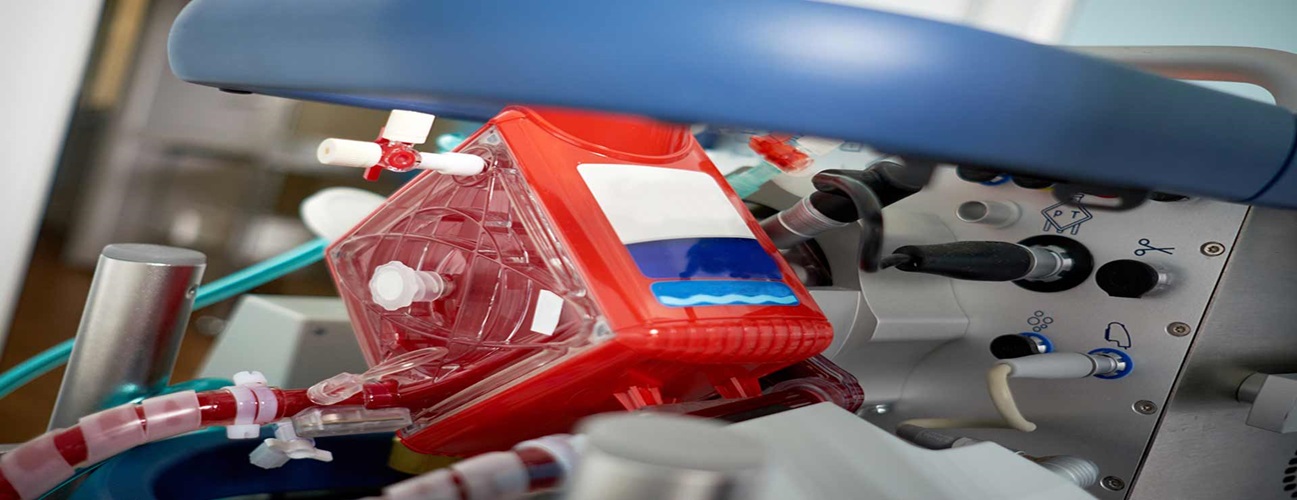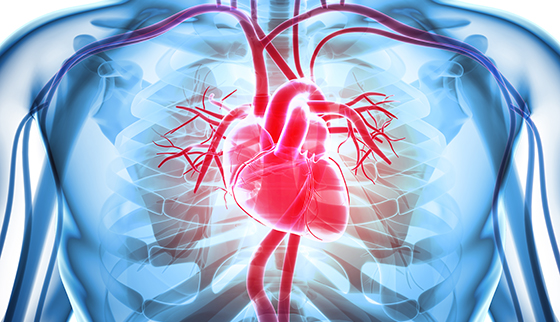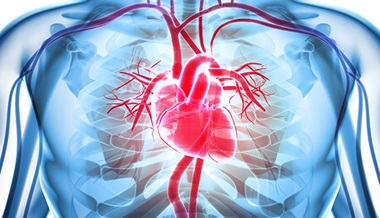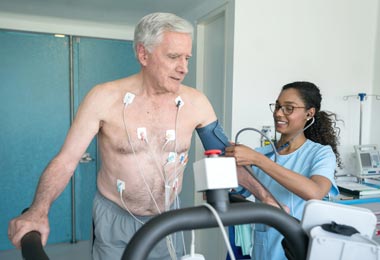Extracorporeal Membrane Oxygenation (ECMO)
What is ECMO (extracorporeal membrane oxygenation)?
ECMO is a form of life support for people with life-threatening illness or injury that affects the function of their heart or lungs. ECMO keeps blood moving through the body and keeps blood gasses (oxygen and carbon dioxide) in balance.
ECMO does not treat lung or heart failure, but does the jobs of the heart and lungs temporarily ― allowing them to “rest.” It uses a machine outside the body (extracorporeal). The machine pumps the blood, provides it with oxygen and helps the body get rid of carbon dioxide.
Heart, Lungs, Oxygen and Carbon Dioxide
Oxygen is essential to every cell in the body. A person with functioning heart and lungs breathes in (inhales), and oxygen from the air enters the bloodstream through the lungs. The heart pumps the blood, circulating oxygen to the tissues and organs to keep them alive and working properly. Circulating blood also removes carbon dioxide from the blood and carries it to the lungs, where it leaves the body through exhalation (breathing out).
Who can benefit from ECMO treatment?
Doctors might recommend ECMO for someone affected by severe trauma or infection, cardiac arrest, lung failure or heart failure. Doctors can use ECMO to stabilize a severely ill patient while they are determining the diagnosis or starting treatment. ECMO can support blood oxygen and circulation for someone awaiting a heart or lung transplant.
How do I prepare for ECMO?
Since ECMO is a life-support procedure, in most cases it takes place in an emergency care setting, where the doctor and care team prepare the patient.
How does ECMO work?
ECMO treatment is delivered by a perfusionist, a person highly skilled in operating the ECMO machine in the intensive care unit (ICU). The perfusionist continuously monitors the patient and adjusts the settings on the ECMO machine.
When the patient is sedated and comfortable, caregivers place plastic tubes called cannulas into the large veins and arteries in the patient’s leg, chest or neck. These cannulas will connect to the ECMO machine.
Blood is carried out through one canula and drains into a plastic pouch, or bladder. Next, the blood moves through the ECMO machine by a pump, which takes over the function of the heart and is adjusted to the patient’s needs throughout treatment.
The blood is then pumped through a type of artificial lung called a membrane oxygenator. This device puts oxygen into the blood and removes carbon dioxide as the lungs would do. A ventilator with a breathing tube may be used at the same time.
After going through the artificial lung, the blood passes through a heat exchanger, which warms the blood to body temperature. Finally, the blood reenters the body through another large cannula.
Patients receiving ECMO may be given medications to relax them, control pain and keep their blood thin. Some patients get medicine to help them sleep, while others are conscious during ECMO treatment and can communicate and move about (carefully, so as not to block the tubes transporting their blood in and out of the machine). Nutrition can be delivered though an intravenous line (parenteral) or directly into the digestive tract through a feeding tube (enteral).
ECMO treatment often takes place in the intensive care unit. The machine is connected to monitors so caregivers can ensure that it is working properly and make adjustments if necessary. ICU caregivers carefully watch the patient’s heart rate, blood pressure and blood gas levels.
Conquering Covid | Maria's Story
How long does ECMO last?
The duration of ECMO treatment depends on the underlying problem with the person’s heart or lungs. ECMO treatment may last only a few hours or days, but in some cases, ECMO might continue for weeks. Before the COVID-19 pandemic, the average ECMO treatment lasted about 10 days, according to Glenn Whitman, M.D., director of the cardiovascular surgical intensive care unit. Advances in life-support technologies and expertise, such as those being made at Johns Hopkins Medicine, are making it possible for patients to remain on ECMO for much longer.
What happens after ECMO?
When doctors are successful in treating the underlying heart or lung condition, ECMO treatment can be gradually tapered. The perfusionist works with the patient and the doctors to decrease the settings of the ECMO machine and let the patient’s heart and lungs take over. This happens very carefully and in stages, so the care team can make sure the patient’s lungs and heart activity remain stable. Once the ECMO is no longer needed, the team removes the cannulas and closes the areas where they entered the body.
End of Life
Sometimes ECMO can give doctors time to find out what the underlying cause of the heart or lung failure is and address it, giving the patient a chance to recover. But sometimes the problem with the patient’s heart or lungs cannot be fixed with medicine or surgery, and this is a very difficult and sad situation. Patients or their families may need to consult with caregivers, clergy and others to understand the prognosis and determine whether or not to continue life support, including ECMO treatment.
ECMO for Babies and Children
The ECMO machine can do the work of children’s heart and lungs while they are recovering from a life-threating (yet treatable) problem. While on ECMO, your child will receive medications to stay comfortable, nutrition, and blood thinner to help prevent the blood from clotting and to help it flow through the ECMO machine. Some of the conditions that can involve ECMO in babies and children include:
- Meconium aspiration in a newborn
- Congenital (present at birth) diaphragmatic hernia
- Persistent pulmonary hypertension
- Sepsis
- Aspiration
- Pneumonia
- Electrolyte disturbance
ECMO and Pediatric Heart Conditions
Congenital (present at birth) or acquired heart conditions, including myocarditis or congenital heart disease, can require a child to be placed on ECMO life support. ECMO can be used to support your child’s recovery after cardiac surgery until his or her heart and lungs are recovered enough to function on their own.
Your Child on ECMO
An ECMO specialist will take blood samples frequently from your child and the ECMO machine, and make adjustments based on blood counts and oxygen levels. All your child’s blood tests and medications are strictly prepared, checked and recorded. Other types of equipment, including a variety of monitors, may be at your child’s bedside to support his or her care. You will see a ventilator connected to a breathing tube placed in your child’s mouth that goes into his or her lungs. Several intravenous (IV) lines provide medication and nutrition. Learn more: ECMO treatment at Johns Hopkins Children’s Center
What are the risks of ECMO?
Bleeding
Patients on ECMO require blood-thinning medication, and this can raise the risk of bleeding. Caregivers take steps to watch for this serious ECMO complication. Bleeding can occur in the brain, lungs, stomach, or where the cannulas (tubes) enter the body, and can be life threatening. Bleeding episodes may be managed with medication, surgery, transfusion or a combination of these approaches.
Mechanical Failure
The ECMO machine comprises many parts, all connected into a closed, smoothly flowing circuit. A malfunctioning part can cause blood loss or let air into the circuit, either of which could cause death or damage to any of the organs, including the brain. The ECMO specialist has been trained to deal with emergency situations, but cannot prevent all possible complications.
Stroke
ECMO treatment involves the use of blood thinners to prevent clots. If a clot occurs, it can end up in the brain, blocking a blood vessel and causing a stroke.
Leg Problems
If a person on ECMO experiences reduced blood circulation in a leg, cells and tissues may become damaged. Doctors may be able to address the problem by moving the leg cannula to another blood vessel. Severe leg tissue damage may result in amputation. Infection Because ECMO is an invasive procedure on a person who is already very sick, infections are a concern. If germs enter the bloodstream through the cannulas, infections can develop and require treatment with antibiotics to prevent further organ damage.
Kidney Failure
ECMO treatment can cause insufficient blood flow in and out of the kidneys. Kidney damage from ECMO can be temporary or permanent, requiring dialysis.







